

TheDifferenceBetweenUniversalDesignforLearningUDLandTraditionalEducation. 5ExamplesofUniversalDesignforLearningintheClassroom. iPad Information - UDL Connect. 'reading' in UDL - Universal Design for Learning. 6 Ways to Engage Every Learner Using UDL. Special Needs 6 Ways to Engage Every Learner Using UDL Universal Design for Learning can make your lessons more accessible and your lesson-planning more fun.
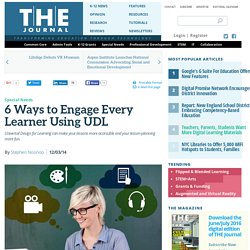
In any given classroom, there are invariably learners who simply don’t connect with what’s being taught. Lectures can be easy to tune out. A textbook can feel dense and boring to finish. Universal Design for Learning: Meeting the Needs of All Students. Katherine, a speech-language pathologist in a large elementary school, works hard to provide appropriate and relevant services to students in general education classrooms.
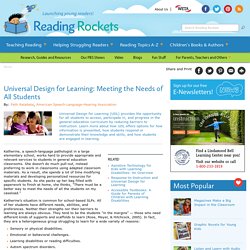
She doesn't do much pull-out, instead preferring to work in classrooms using adapted classroom materials. As a result, she spends a lot of time modifying materials and developing personalized resources for specific students. As she packs up her bag filled with paperwork to finish at home, she thinks, "There must be a better way to meet the needs of all the students on my caseload.
" UDLStrategies - home. UDL Examples and Resources. Disclaimer: The examples and resources highlighted on these pages have been gathered for educational purposes.
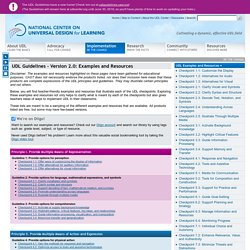
CAST does not necessarily endorse the products listed, nor does their inclusion here mean that these products are complete expressions of the UDL principles and guidelines. They may illustrate certain principles and not others. Below, you will find teacher-friendly examples and resources that illustrate each of the UDL checkpoints. Exploring these examples and resources not only helps to clarify what is meant by each of the checkpoints but also gives teachers ideas of ways to implement UDL in their classrooms. These lists are meant to be a sampling of the different examples and resources that are available. We're on Diigo! Want to search our examples and resources? Never used Diigo before?
Udltechtoolkit - Literacy tools. UDL in the Language Arts Classroom. What is Universal Design for Learning?

UDL is the development of curriculum that meets all students' learning needs. No matter their learning style, behavior, background, culture, race, gender, or physical difficulties, all students have a right to quality instruction that helps them meet their learning goals. The diverse students we teach come from a variety of backgrounds and cultures. Each student has specific learning needs, each student has learning strengths in every subject area, and each student brings unique prior knowledge to our school.
We can not reach every student using a "one-size-fits-all" approach to our curriculum. Research about how the brain works suggests the importance of UDL for reaching and engaging all students. Technology plays a central role in UDL, as it allows teachers to provide multiple means of representation to meet diverse learners' needs. Follow this link to hear Dr. UDL Book Builder is an exciting tool developed by CAST. UDL for All Learners. The Center for Applied Special Technology (CAST) was founded in 1984 at the same time the report A Nation at Risk was released about the state of education that expressed the need to provide all individuals with full and equal educational opportunities.

CAST envisioned new technologies as learning tools for learners especially those with disabilities. Ann Meyers and David Rose from CAST developed Universal Design for Learning (UDL) [www.cast.org]. What they found out in the early years at CAST is that UDL was not about learners overcoming their barriers; it was about reducing or eliminating the barriers that keep learners from learning. Wisconsin Department of Public Instruction. Universal Design for Learning (UDL) is a scientifically valid framework that provides multiple means of access, assessment, and engagement and removes barriers in instruction to achieve academic and behavioral success for all.

The Universal Design for Learning framework can provide educators with a structure to develop their instruction to meet the wide range of diversity among all learners. Universal Design for Learning is based on brain research that suggests a one-size-fits-all approach to education is not effective. The inspiration behind Universal Design for Learning was the concept of universal design in architecture, where design features intended for individuals with disabilities have had unexpected benefits for the general population (e.g. curb cut outs designed for wheelchair access have benefits for strollers, rolling luggage, skateboarders, etc.) There are three main principles of Universal Design for Learning: 1. 2. 3.
The Importance of Universal Design for Learning. When a student struggles in the classroom, questions usually focus on the student: Does she have a learning disability?
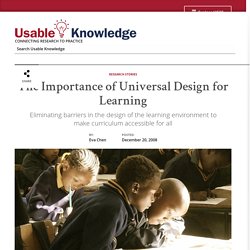
Is this student's reading skill not on par with the other children in the class? Does he not pay enough attention when sitting in class or doing homework? Until recently, there has been comparatively little focus on the role of the curriculum in these struggles. Thanks to work by Harvard Graduate School of Education Lecturer David Rose, the chief education officer of the Center for Applied Special Technology (CAST), researchers and educators alike are now examining how the curriculum, not the student, may be disabled, and how curriculum disabilities can be overcome.
The idea of curriculum disability arose when Rose was working with other neuropsychologists at the North Shore Children's Hospital (near Boston) to evaluate children who were performing poorly in school. UDL At A Glance. Universal Design for Learning - The ACCESS Project - Colorado State University. The Best Practices through UDL video features faculty and students at Colorado State University discussing the benefits of UDL.
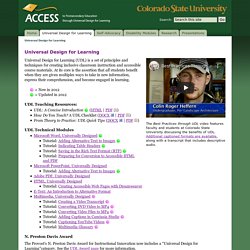
Additional captioned formats are available, along with a transcript that includes descriptive audio. Universal Design for Learning (UDL) is a set of principles and techniques for creating inclusive classroom instruction and accessible course materials. At its core is the assertion that all students benefit when they are given multiples ways to take in new information, express their comprehension, and become engaged in learning. Guidelines and Principles : About UDL : Universal Design For Learning : University of Vermont. About Universal Design for Learning (UDL) Examples of UDL in Practice Guidelines and Principles of UDL The goal of education in the 21st century is not simply the mastery of knowledge.
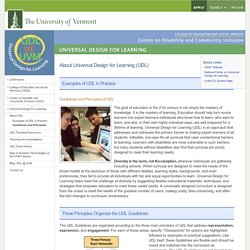
It is the mastery of learning. Education should help turn novice learners into expert learners-individuals who know how to learn, who want to learn, and who, in their own highly individual ways, are well prepared for a lifetime of learning. Diversity is the norm, not the exception, wherever individuals are gathered, including schools. Three Principles Organize the UDL Guidelines The UDL Guidelines are organized according to the three main principles of UDL that address representation, expression, and engagement. Like UDL itself, these Guidelines are flexible and should be mixed and matched into the curriculum as appropriate. As a way of utilizing the principle of multiple means of representation we present the graphic left.
About Universal Design for Learning. Home. Accommodations and Modifications Training. The 7 Principles of UDL. Concepts of universal design and what an accessible course and classroom look like. Universal Design for Learning. Equal Access: Universal Design of Instruction. 7 Principles of UD. Meet The Normals - Adventures in Universal Design. What Is Differentiated Instruction? This article was excerpted from the Scholastic Professional title, Differentiating Reading Instruction, by Laura Robb.
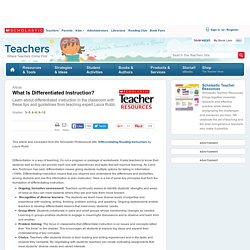
Differentiation is a way of teaching; it’s not a program or package of worksheets. It asks teachers to know their students well so they can provide each one with experiences and tasks that will improve learning. As Carol Ann Tomlinson has said, differentiation means giving students multiple options for taking in information (1999). Differentiating instruction means that you observe and understand the differences and similarities among students and use this information to plan instruction. Here is a list of some key principles that form the foundation of differentiating instruction. Ongoing, formative assessment: Teachers continually assess to identify students’ strengths and areas of need so they can meet students where they are and help them move forward.
Data That Supports Differentiation in Reading Step Inside My Classroom Make your read alouds a common teaching text. UDL Lesson Builder: Explore Model UDL Lesson Plans. Udltechtoolkit - home. UDL Learning Wheel. Universal-Design. Universal Design for Learning Guides, Part 1: Principles of Universal Design. Universal Learning Design: Empowering the Next Generation. UDL_UDT_presentation (3) K-12 Tech Tools © - home. UDL Resource - Home. Classroom Resources.
National Center On Universal Design for Learning. UDL Guidelines 2.0. The goal of education in the 21st century is not simply the mastery of content knowledge or use of new technologies. It is the mastery of the learning process. Education should help turn novice learners into expert learners—individuals who want to learn, who know how to learn strategically, and who, in their own highly individual and flexible ways, are well prepared for a lifetime of learning.
Universal Design for Learning (UDL) helps educators meet this goal by providing a framework for understanding how to create curricula that meets the needs of all learners from the start. The UDL Guidelines, an articulation of the UDL framework, can assist anyone who plans lessons/units of study or develops curricula (goals, methods, materials, and assessments) to reduce barriers, as well as optimize levels of challenge and support, to meet the needs of all learners from the start. They can also help educators identify the barriers found in existing curricula. Universal Design for Transition-Self Advocacy Unit 1 by Darliss Bardwell on Prezi.
YouTube Videos. The UDL Guidelines. UDL: Principles and Practice. Universal Design for Learning (UDL) UDL Lesson Plan Ideas. UDL Toolkits: Teaching Every Student. The Planning for All Learners (PAL) process builds upon two prerequisites: A basic understanding of Universal Design for Learning, andCommitment of participating educators to make the curriculum and learning accessible for all learners. The PAL process begins with the formation of the PAL team, comprised of general education and special education teachers and other appropriate educational specialists at one grade level or with a content specific focus. The team meets regularly during the school year to focus on the foundation of instruction — the curriculum. Identification of a strong team facilitator, responsible for scheduling meetings and agenda, providing and/or facilitating "just in time" support, and actively promoting a growing PAL initiative, is essential to the success of the PAL team. The work of the PAL team must always be aligned with local district and school initiatives, and is guided by state and local curriculum standards.
TeachEvaluate lesson/unitRevise lesson/unit. UDL Exchange: Home.